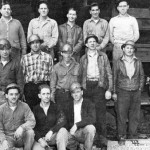

Ron Centanni, of Ponchatoula LA, provided these pictures of Delta Shipbuilding Co.'s work during World War II. His father, Rosario (Roy) J. Centanni, worked at the shipyard and is shown here (second row, second from left with plaid shirt) with fellow workers in December 1944. Ron is unable to identify any other men in the photo.
World War II broke out in New Orleans during Maestri’s administration. New Orleans’s shipyards were quickly expanded-the Delta Shipyards turned out the first 1o,500-ton ship, the Wm. C. C. Claiborne, less than four months after Pearl Harbor-and by May, 1942, Andrew Jackson Higgins ha gathered a force of more than forty thousand workers to turn out PT boats and landing craft for the Navy. Meanwhile, the realities of the conflict were vividly brought home to New Orleanians: thirteen ships-some of them from New Orleans-were sunk in -the Gulf of Mexico by the end of May, and German submarines lurked not far off the mouth of the Mississippi. Rationing of meat and other foods, rationing of gasoline, scrap drives, practice blackouts, recapped tires, air-raid-wardens’ meetings, and women streetcar operators soon became the order of the day. Mardi Gras festivities were canceled for the duration, and New Orleanians set about the grim business of producing more, shipping more, and doing with less. A brand new streamlined Panama Limited, crack Chicago-New Orleans train of the Illinois CentraI Railroad began operations during this time.
The surrender of Germany came on May 7, 1945, and New Orleanians celebrated, “though not as noisily as in 1918,” remarked the Times-Picayune. Business came to a standstill, and streetcars were routed off Canal Street. Whistles and horns were blown, “people yelled, sang and cried in happiness,” and some five thousand marchers carrying Japanese lanterns paraded that night. The casualties for this “quiet” celebration were reported by the police as about a hundred arrests for drunkenness, nine shot, thirteen stabbed, five fractured skulls, and one person dead.
The surrender of the Japanese on September 2, 1945, brought only a mild reaction from the people -except the-members of the Bourbon Street -Chinese colony, who celebrated noisily I by setting off $500 worth of firecrackers by special permission of the police, and by burning a’ effigy of Tojo.
To learn more about how significant New Orleans was in World War II you must visit the The National World War II Museum in the warehouse district. It is an amazing time capsula to our American History during this time period. They have recently added a 4D theater to help bring alive this magnificant history. I recommend reading the Hotel Monteleone’s review of The National World War II Museum in New Orleans for more information.
